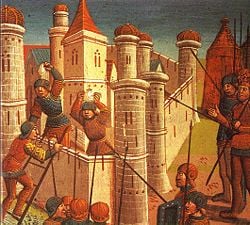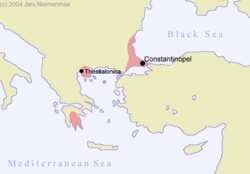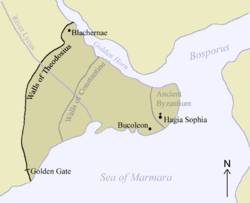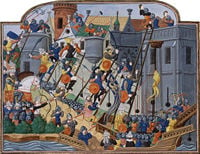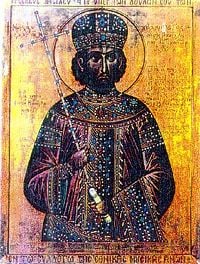Constantinople, Fall of
The Fall of Constantinople was the conquest of the Byzantine capital by the Ottoman Empire under the command of Sultan Mehmed II, on Tuesday, May 29, 1453. This marked not only the final destruction of the Eastern Roman Empire, and the death of Constantine XI, the last Byzantine emperor, but also the strategic conquest crucial for Ottoman rule over the Eastern Mediterranean and Balkans. The city remained capital of the Ottoman Empire until the empire's dissolution in 1922, and was officially renamed Istanbul by the Turkish Republic in 1930. The conquest of Constantinople and subsequent expansion into the Balkans more than compensated for the loss of Muslim possessions in Spain. The Muslim world had long coveted Constantinople and from Muhammad's time onwards the Islam world had wanted to conquer the Byzantine Empire, to whom they always referred as 'Romans'. In Europe, the Fall of Constantinople was an iconic and tragic moment. The Byzantines represented a direct link with the Roman Empire on whose foundations Europe had been consciously built, and whose legacy continued to inform much of European thought, political and social and legal practice.
Although Western Europe was religiously divided from the Byzantine Orthodox Church, which they considered heretical, psychologically the loss of Constantinople impacted throughout Europe. The Muslims were perceived as a threat, and now that the Christian Empire in the East had fallen, an important buffer between Europe and the Muslim world had been removed. As the Balkans also fell, the Ottoman troops would reach the gates of Vienna itself, a center of European culture par excellence. Although important commercial ties with Constantinople would continue, Europeans never forgave the Turks for seizing Europe's remaining link to its cherished Roman heritage. Turks and Muslims were demonized as those who opposed progress and the true faith. No effort was made to inquire whether God's voice might also be speaking through their religion. Europe continued to mourn the loss of Constantinople, even though Europeans had not been consistent friends of the city they claimed to hold in such high esteem, having sacked it in 1203-4 when the Latin Kingdom was established (until 1261).
State of the Byzantine Empire
In the approximately 1,000 years of the existence of the Byzantine Empire, Constantinople had been besieged many times; it had been captured only twice, during the Fourth Crusade in 1204, and when the Byzantines retook it decades later. The crusaders, however, had not originally set out to conquer the Empire, and the Byzantines re-established themselves in the city in 1261. In the following two centuries, the much-weakened empire was gradually taken piece by piece by a new threat, the Ottoman Empire. In 1453, the "empire" consisted of little more than the city of Constantinople itself and a portion of the Peloponnese (centered on the fortress of Mystras); the Empire of Trebizond, a completely independent successor state formed in the aftermath of the Fourth Crusade also survived on the coast of the Black Sea.
Preparations
Mehmed, whose great-grandfather Bayezid I had previously built a fortress on the Asian side of the Bosporus called Anadolu Hisarı, now built a second castle outside the walls of Constantinople on the European side, which would increase Turkish influence on the straits. An especially relevant aspect of this fortress was its ability to prevent help from Genoese colonies on the Black Sea coast from reaching the city. This castle was called Rumeli Hisarı; Rumeli and Anadolu being the names of European and Asian portions of the Ottoman Empire, respectively. The new fortress is also known as Boğazkesen which has a dual meaning in Turkish; strait-blocker or throat-cutter, emphasizing its strategic position. The Greek name of the fortress, Laimokopia, also bears the same double-meaning. Meanwhile, Constantine XI tried to buy him off with gifts. The closing of the small mosques within Constantinople by Constantine XI and the pressures on Greek Muslims to convert back to Christianity formed the pretext for Mehmed to declare war.
Constantine appealed to Western Europe for help, but his request didn't meet the expected attention. Ever since the mutual excommunication of the Orthodox and Roman Catholic churches in 1054, the Roman Catholic west had been trying to re-integrate the east; Union had been attempted before at Lyons in 1274, and, indeed, some Paleologan emperors had been received in the Latin Church since. Emperor John VIII Palaeologus had attempted to negotiate Union with Pope Eugene IV, and the Council held in 1439, resulted in the proclamation, in Florence, of a Bull of Union. In the following years, a massive propaganda initiative was undertaken by anti-unionist forces in Constantinople and the population was in fact bitterly divided. Latent ethnic hatred between Greeks and Italians stemming from the stranglehold the Italians had over the Byzantine economy and the sack of Constantinople in 1204, also played a significant role, and finally the Union failed, greatly annoying Pope Nicholas V and the Roman Catholic church.
However, even if he had been more eager to help, Pope Nicholas V did not have the influence the Byzantines thought he had over the Western Kings and princes, and these had not the wherewithal to contribute to the effort, especially in light of France and England being weakened from the Hundred Years' War, Iberian Kingdoms being in the final part of the Reconquista, the internecine fighting in the German Principalities, and Hungary and Poland's defeat at the Battle of Varna of 1444. Although some troops did arrive from the city states of what today is the north of Italy, the Western contribution was not adequate to counterbalance the Ottoman strength.
The Byzantine army itself totaled about 7000 men, 2000 of whom were foreign mercenaries. The city also had fourteen miles of walls, probably the strongest set of fortified walls in existence at the time. The Ottomans, on the other hand, had a larger force. It was thought to be numbering around 100,000, including 20,000 Janissaries, but recent estimates cite 80,000 soldiers and 5,000 Janissaries. Mehmed also built a fleet to besiege the city from the sea, comprising mostly Greek soldiers.[1]
The Ottomans employed a Hungarian engineer called Urban, who was a specialist in the construction of cannons, which were still relatively new weapons. He built an enormous cannon, nearly twenty-seven feet (more than 8m) in length and 2.5 feet (about 75 cm) in diameter, which could fire a 1200 lb (544 kg) ball as far as one mile. It was dubbed "the Basilic." Although the Byzantines also had cannons, they were much smaller and their recoil tended to damage their own walls. Urban's cannon had several drawbacks, however. It could hardly hit anything, not even as large as Constantinople, it took three hours to reload, the cannon balls were in very short supply, and the cannon collapsed under its own recoil after six weeks.
Another expert that was employed by the Ottomans was Ciriaco de Pizzicoli, also known as Ciriaco of Ancona, traveler, and collector of antiquities.
Siege and final assault of the city
Mehmed planned to attack the Theodosian Walls, the intricate series of walls and ditches protecting Constantinople from an attack from the west, the only part of the city not surrounded by water. His army encamped outside the city on Easter Monday, April 2, 1453. For weeks, Mehmed's massive cannon fired on the walls, but it was unable to sufficiently penetrate them, and due to its extremely slow rate of reloading the Byzantines were able to repair most of the damage after each shot. Meanwhile, Mehmed's fleet could not enter the Golden Horn due to the boom the Byzantines had laid across the entrance. To circumvent this, he built a road of greased logs across Galata on the north side of the Golden Horn, and rolled his ships across. This succeeded in stopping the flow of supplies from Genoan ships and demoralized the Byzantine defenders. Furthermore, the defenders were forced to disperse part of their forces to the Golden Horn walls, causing defense in other walls to weaken.
The Turks made numerous frontal assaults on the wall, but were repelled with heavy losses. They then sought to break through the walls by constructing underground tunnels in an effort to sap them. Many of the sappers were Serbians sent from Novo Brdo by the Serbian Despot. They were placed under the rule of Zaganos Pasha. However, the Byzantines employed an engineer named Johannes Grant (who was said to be German but was probably Scottish), who had counter-tunnels dug, allowing Byzantine troops to enter the tunnels and kill the Turkish workers. Other Turkish tunnels were flooded with water. Eventually, the Byzantines captured and tortured an important Turkish engineer, who revealed the location of all the Turkish tunnels, which were then destroyed.
Mehmed offered to raise the siege for an astronomical tribute that he knew the city would be unable to pay. When this was declined, Mehmed planned to overpower the walls by sheer force, knowing that the Byzantine defenders would be worn out before he ran out of troops.
On the night of May 22, there was a lunar eclipse, which must have seemed a bad omen to the defenders of the city. On the morning of May 29, the attack began. The first wave of attackers, the azabs (auxilaries), were poorly trained and equipped, and were meant only to kill as many Byzantine defenders as possible. The second assault, consisting largely of Anatolians, focused on a section of the Blachernae walls in the northwest part of the city, which had been partially damaged by the cannon. This section of the walls had been built much more recently, in the eleventh century, and was much weaker; the crusaders in 1204 had broken through the walls there. The Ottoman attackers also managed to break through, but were just as quickly pushed back out by the Byzantine defenders. The Byzantines also managed for a time to hold off the third attack by the Sultan's elite Janissaries, but a Genoan general in charge of a section of the defense, Giovanni Giustiniani, was grievously wounded during the attack, and his evacuation from the ramparts caused a panic in the ranks of the defenders.
Some historians suggest that the Kerkoporta gate in the Blachernae section had been left unlocked, and the Ottomans soon discovered this mistake (there was no question of bribery or deceit by the Ottomans; the gate had simply been overlooked, probably because rubble from a cannon attack had obscured or blocked the door). The Ottomans rushed in. Constantine XI himself led the last defense of the city, and throwing aside his purple regalia, dove headfirst into the rushing Ottomans, dying in the ensuing battle in the streets, like his soldiers.
Aftermath
Mehmed had promised his troops they could loot the city for three days, in accordance with ancient military tradition. He had also threatened Emperor Constantine XI that if the city resisted, the civilians would not be spared. Indeed many civilians were slaughtered by the Turks when they first burst through the walls and captured the towers on the land walls, although order was quickly restored. After the initial assault, the Ottoman army fanned out along the main thoroughfare of the city, the Mese, past the great forums, and past the mammoth church of the Holy Apostles, which Mehmet purposely spared to provide a seat for his new patriarch, which would tend his Christian flock. Mehmet had sent an advance guard to protect key buildings such as the Holy Apostles, as he had absolutely no intention of inheriting a thoroughly devastated city. The Army converged upon the Augusteum, the vast square that fronted the great church of Haghia Sophia whose bronze gates were barred by a huge throng of civilians inside the building, hoping for divine protection at this late hour. After the doors were breached, the troupes separated the congregation according to what price they might bring on the slave markets. A few of the elderly and some infants were summarily slain with a commercial ruthlessness. Soldiers fought over the possession of richly clad senators or for the comely youth or maiden. Legend holds that two priests saying mass over the crowd disappeared into the cathedral's walls as the first Turkish soldiers entered. According to the legend, the priests will appear again on the day Constantinople returns to Christian Hands.[2]
Although Mehmet II allowed the rape, pillage, and looting of the city, as was the custom of all armies during that age, he changed his mind after seeing the great structures of the city being destroyed and stopped the activities after 24 hours; unfortunately at that point a large part of the populace was either raped, despoiled, or enslaved. Of the estimated 50,000 persons residing in the city at the time of its capture, approximately half were still free when Mehmet issued his order to cease the pillage of the city. The reason that so many of the civilian population escaped enslavement was primarily due to the topography of the city at the time. Far from being in its heyday, Constantinople was severely depopulated for years following the depredations from the Bubonic plague and especially from the disaster of the Fourth Crusade inflicted on it by the Christian army two centuries before. Therefore, the city in 1453, was a series of walled villages separated by vast fields encircled in whole by the fourth century Theodosian walls. When the Ottoman troops first broke through the defenses, many of the leading citizens of these little townlets submitted their surrender to Mehmet's generals, thereby falling within the proscriptions of honored Islamic traditions of voluntary submission. These villages, specifically along the land walls, were allowed to keep their citizens and churches from molestation by the Ottoman troupes and were protected by Mehmet's special contingents of Jannissaries. It was these people who were to ransom their fellow citizens after Mehmet's general cessation of the looting of the city and who formed what the Ottomans' called a Millet, or self governing community in the multi-national empire of what would become Ottoman Istanbul.

Mehmed waited until the area was secured and entered the city in a ceremonial procession where the local population brought him flowers in congratulations. His initial impression was that the city had fallen into disrepair, a trend that began after Constantinople was conquered in the Fourth Crusade.
In Mehmed's view, he was the successor to the Roman Emperor. He named himself "Kayzer-i Rum," the Roman Caesar, but he was nicknamed "the Conqueror." Constantinople became the new capital of the Ottoman Empire. Hagia Sophia was converted into a mosque, although the Greek Orthodox Church remained intact, and Gennadius Scholarius was appointed Patriarch of Constantinople.
Popular belief holds that many Greeks fled the city and found refuge in the Latin West, bringing with them knowledge and documents from the Greco-Roman tradition that further propelled the Renaissance. This is true to some extent, but the influx of Greek scholars into the West began much earlier, especially in the Northern Italian city-states which had started welcoming scholars in the eleventh and twelfth centuries. The chancellor of Florence Coluccio Salutati began this cultural exchange in 1396 by inviting a Byzantine Scholar to lecture at the University of Florence. It was the Italians' hunger for Latin Classics and a command of the Greek Language that fueled the Renaissance. Those Greeks who stayed behind in Constantinople were mostly confined to the Phanar and Galata districts. The Phanariots, as they were called, provided many capable advisers to the Ottoman sultans, but were seen as traitors by many Greeks.
The Morean (Peloponnesian) fortress of Mystras, where Constantine's brothers Thomas and Demetrius ruled, constantly in conflict with each other and knowing that Mehmed would eventually invade them as well, held out until 1460. Long before the fall of Constantinople, Demetrius had fought for the throne with Thomas, Constantine, and their other brothers John and Theodore. Thomas escaped to Rome when the Ottomans invaded Morea while Demetrius expected to rule a puppet state, but instead was imprisoned and remained there for the rest of his life. In Rome, Thomas and his family received some monetary support from the Pope and other western rulers as Byzantine emperor in exile, until 1503. In 1461, the autonomous Byzantine state in Trebizond fell to Mehmed.
Scholars consider the Fall of Constantinople as a key event ending the Middle Ages and starting the Renaissance because of the end of the old religious order in Europe and the use of cannon and gunpowder. The fall of Constantinople also severed the main overland trade link between Europe and Asia. As a result, more Europeans began to seriously consider the possibility of reaching Asia by sea—this would eventually lead to the European discovery of the New World.
Down to the present day, many Greeks have considered Tuesday (the day of the week that Constantinople fell) to be the unluckiest day of the week.
Notes
- ↑ David Nicole, Constantinople 1453 (Oxford: Osprey Publishing, 2000). ISBN 1841760919
- ↑ Mortimer Chambers, Barbara Hanawalt, Theodore Rab, Isser Woloch, and Raymon Grew, The Western Experience (New York: McGraw-Hill, 2003). ISBN 0073259993
ReferencesISBN links support NWE through referral fees
- Babinger, Franz. Mehmed the Conqueror and His Time. Princeton, N.J.: Princeton University Press, 1978. ISBN 0691099006
- Fletcher, Richard A. The Cross and the Crescent. New York: Viking, 2004. ISBN 0670032719
- Melville-Jones, John, trans. "The Siege of Constantinople (1453) according to Nicolo Barbaro." Retrieved February 14, 2007.
- Norwich, John Julius Byzantium:The Decline and Fall., New York: Alfred A. Knopf, 1995. ISBN 0679416501
- Runciman, Steven. The Fall of Constantinople, 1453. Cambridge: Cambridge University Press, 1990. ISBN 0521398320
- Smith, Michael Llewellyn. "The Fall of Constantinople." History Makers magazine No. 5, London: Marshall Cavendish, Sidgwick & Jackson, 1969, p. 192.
- Wheatcroft, Andrew. The Infidels: The Conflict Between Christendom and Islam, 638-2002. London: Viking, 2003. ISBN 0670869422
- Wintle, Justin. The Rough Guide History of Islam. London: Rough Guides, 2003. ISBN 184353018X
External links
All links retrieved March 20, 2017.
- "The Trouble with Turkey: The Fall of Constantinople", The Economist, 1999.
Credits
New World Encyclopedia writers and editors rewrote and completed the Wikipedia article in accordance with New World Encyclopedia standards. This article abides by terms of the Creative Commons CC-by-sa 3.0 License (CC-by-sa), which may be used and disseminated with proper attribution. Credit is due under the terms of this license that can reference both the New World Encyclopedia contributors and the selfless volunteer contributors of the Wikimedia Foundation. To cite this article click here for a list of acceptable citing formats.The history of earlier contributions by wikipedians is accessible to researchers here:
The history of this article since it was imported to New World Encyclopedia:
Note: Some restrictions may apply to use of individual images which are separately licensed.
